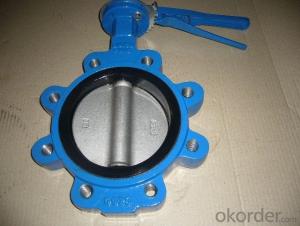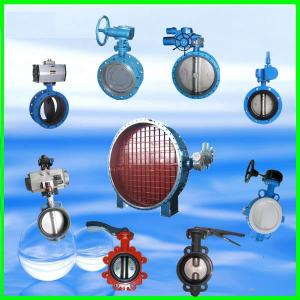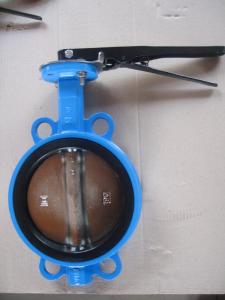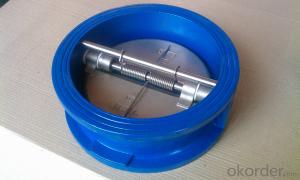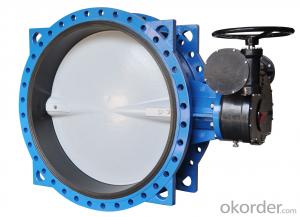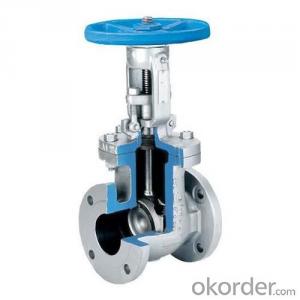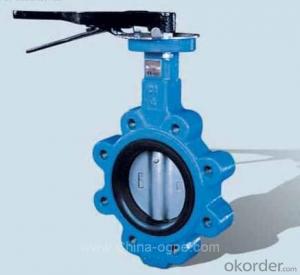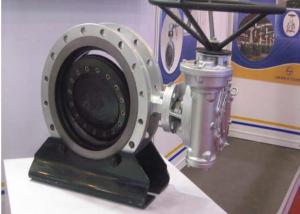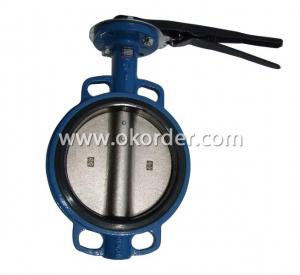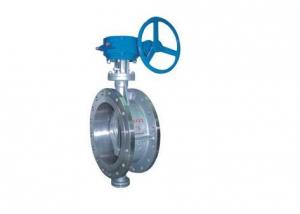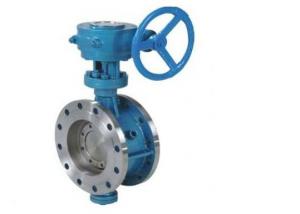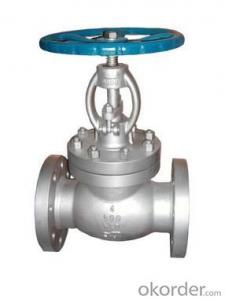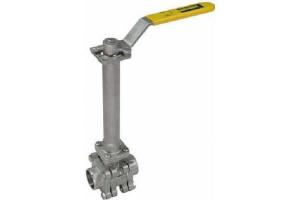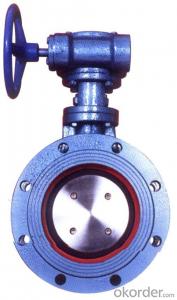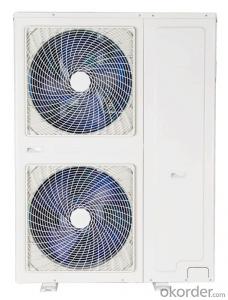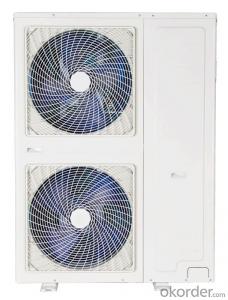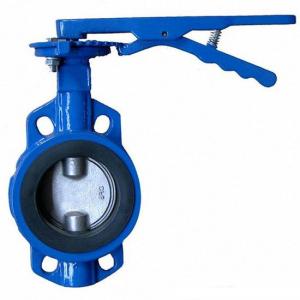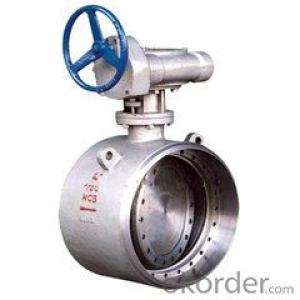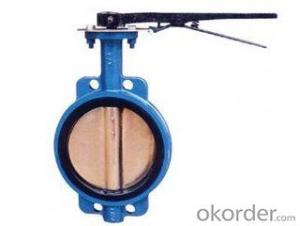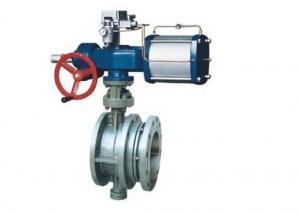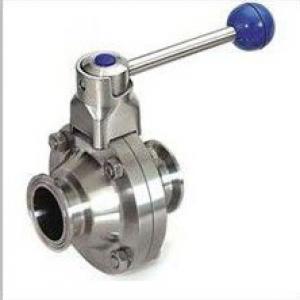Butterfly Valve Without Pin Ductile Iron DN130
- Loading Port:
- Tianjin
- Payment Terms:
- TT OR LC
- Min Order Qty:
- 50 set
- Supply Capability:
- 50000 set/month
OKorder Service Pledge
Quality Product, Order Online Tracking, Timely Delivery
OKorder Financial Service
Credit Rating, Credit Services, Credit Purchasing
You Might Also Like
Centerline structure,pinless double half shaft design.
Disc has two-way bearing, no installation direction requirements.
Non-backed replaceable seat with good performance and a longer working life.
Square and short neck for lable use and cost saving.
Easy installation, no need flange gasket.
| Size | DN50mm-DN600mm |
| Design standard | API609/EN593 |
| End flange | DINPN10/PN16, BS4504PN10/PN16, ANSI class125#/class150# |
| Face to face | API609/EN558-1 |
| Top flange | ISO5211 |
| Body | Ductile iron/Cast iron |
| Disc | Ductile iron/CF8/CF8M/C95400/C95500 |
| Stem | SS420 |
| Seat | EPDM/NBR/Viton/PTFE |
| Actuator | Bare shaft/Lever/Gearbox and handwheel |
| Coating | Epoxy/Nylon/PTFE |
| Pin | With out pin |
| Suitable medium | Water/Seawater/Sewage/Air/Foodstuff/Oil |
- Q:What is the medium flow rate when the centerline butterfly valve is fully open?
- On the pipeline, mainly from cutting and throttling. Butterfly valve headstock is a disc shaped disc, in the valve body around its own axis of rotation, so as to achieve the purpose of opening or closing or regulation.
- Q:Why anti condensation of aluminum alloy anti condensation butterfly valve?
- High performance materials have a lot of outstanding advantages: such as low water absorption, corrosion resistance, insulation, cold insulation performance, etc., is 4 times the ordinary material butterfly valve.Anti condensation butterfly valve body adopts ultra light aluminum alloy valve body, its weight is only 1/3 of the traditional butterfly valve, the torque is small, the use and installation is convenient, and the corrosion is avoided.
- Q:Butterfly valve D71X-1.6C, DN50, there is no difference between C and no C? What do you mean by "concrete"?
- Front is the same, there is C refers to the body of the material is carbon steel, without C, usually refers to gray iron (cast iron is more common, so are generally omitted)
- Q:Butterfly valve common faults and treatment methods?
- Three, summary:Only familiar with every detail of circulating water pump outlet valve and butterfly valve equipment, timely and thorough maintenance and strict debugging, to ensure the safety and reliability of equipment operation, to ensure the healthy and orderly operation of equipment.
- Q:What's the difference between an electric two position control valve and an electric butterfly valve?
- With manual control device, once the power failure occurs, you can temporarily manually operated, and will not affect the use.The biggest difference is that the electric double bit butterfly valve can not fine adjustment; and the electric butterfly valve can play a regulating role.
- Q:What does the butterfly valve model d344h, d345h, d346h, d347h mean?
- According to the international standard of the letters and numbers apart to explain D344H D is a unit of butterfly valve, two unit 3 is driving mode: turbine, three unit 4 connection: flange connection, four unit 4 Structure: seal type linkage, five unit H sealing material: Cr13 stainless steelD345H compare yourself to the above. Unit 5 four is a sealed, single eccentric structureD346H four unit 6 is an unsealed center vertical plateD347H four unit 7 is unsealed double eccentricIn general, there is only one difference between them: the structural form is different!
- Q:D37A1X9-16CB1: what does this butterfly valve mean?
- The model is composed of 7 units, the types of valves (gate valve Z, J, L, Q ball valve, throttle valve, check valve and H valve, butterfly valve, connection mode (D) internal thread 1 thread 2, welding flange 4, 6, 7, the clamp (0) electromagnetic transmission mode 1 solenoid valve, hydraulic, electric and hydraulic turbine are 2, 3, 4 and 5 gears, bevel gear, pneumatic hydraulic, 6, 7, 8, 9) pneumatic and hydraulic, electric, structure (straight or DC type 7,1 on behalf of the center plate, vertical type A (A) and LT X9) on behalf of a sealant is heat-resistant rubber, kg 16 kg, C represents the body material of carbon steel WCB, B1 on behalf of the valve plate is made of ductile cast iron plating)
- Q:Have an iron block, aluminum heads, solid roller lifters, Jessel rocker shafts, what should my valve clearances be cold, and hot??
- Because you apparently have a built engine here rather than a factory assembly which simply has solid lifters, and the data you have is either inconclusive or conflicting then I will recommend the following procedure: Assemble them cold and adjust to Intake .010 and exhaust .020. After firing up the engine, adjust the carb, if it is so equipped, to a smooth rich idle and run it in for a couple of hours mixing idling with moderate load and a few full throttle pulls through 2nd gear to seat the rings. Bring it back into the shop good and hot and set the valve clearances at .008 intake and .016 exhaust hot. After adjusting the valves readjust the idle to 700 RPM and set the timing. initially set the timing at about 2 degrees BTDC until you hav run in the engine, If you are without clear specifications for timing use a vacuum gauge and play with it between 2 and 10 degrees BTDC with the vacuum advance disconnected and plugged, you are looking for the highest vacuum at idle as a starting point. Run it hard including lugging it in high gear at around 2500 to 3500 rpm at or near full throttle, if you are getting spark knock back it down 2 degrees at a time until it does not knock when lugged. If you get no spark knock when lugging it you might try advancing the timing 2 degrees above the vacuum indicated optimal setting but do not go beyond that point. After setting the valves and timing readjust the carburetor to the best lean idle and set to 650 to 700 rpm depending on where it feels comfortable. In the old days a lot of this was done totally by ear - hence the term engineers. Today I think most holders of that revered title do not have a clue where the term came from.
- Q:The difference between the directly buried gate and the flange valve and butterfly valve
- Buried gate also called buried gate valve, valve can be directly buried underground, built without manhole, reduce road excavation area; small well maintained road and beautiful room can reduce the difficulty of construction, reduce project cost. The directly buried soft sealing gate valve is divided into two types: telescopic type and fine fixing type, wherein, the telescopic type is divided into metal type and plastic type. In the process of construction, the telescopic type can be adjusted arbitrarily according to the distance between the buried depth of the valve and the ground, and the micro adjustment can be adjusted on the spot. The directly buried gate valve has the advantages of long-term use, no leakage, no maintenance, etc., and can effectively avoid other people switching the valve and stealing the manhole cover at will.Flange gate valve is connected to the flange gate valve, this connection is the most common way.
- Q:How to calculate the size of the manual butterfly valve?
- I don't know what size you mean, and what about DN in diameter, such as DN125, which means 125 cm in diameter
1. Manufacturer Overview |
|
|---|---|
| Location | |
| Year Established | |
| Annual Output Value | |
| Main Markets | |
| Company Certifications | |
2. Manufacturer Certificates |
|
|---|---|
| a) Certification Name | |
| Range | |
| Reference | |
| Validity Period | |
3. Manufacturer Capability |
|
|---|---|
| a)Trade Capacity | |
| Nearest Port | |
| Export Percentage | |
| No.of Employees in Trade Department | |
| Language Spoken: | |
| b)Factory Information | |
| Factory Size: | |
| No. of Production Lines | |
| Contract Manufacturing | |
| Product Price Range | |
Send your message to us
Butterfly Valve Without Pin Ductile Iron DN130
- Loading Port:
- Tianjin
- Payment Terms:
- TT OR LC
- Min Order Qty:
- 50 set
- Supply Capability:
- 50000 set/month
OKorder Service Pledge
Quality Product, Order Online Tracking, Timely Delivery
OKorder Financial Service
Credit Rating, Credit Services, Credit Purchasing
Similar products
New products
Hot products
Related keywords
